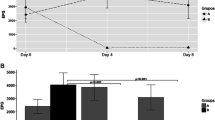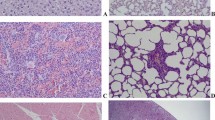Abstract
The aim of the present study was to determine the paramphistomicidal efficacy of methyl [5-chloro-6-(1-naphthyloxy)-1H-benzimidazol-2-yl]carbamate (alpha-carbamate) in experimentally infected sheep. Sixteen crossbred rams were infected each with 600 metacercariae of Calicophoron calicophorum. Forty five days after infection, they were divided into four groups of four animals each. Groups 1 to 3 received compound alpha-carbamate at a dose of 12, 18, and 24 mg/kg b/w, respectively; group 4 serving as the nontreated control. Ten days after treatment, all animals were killed to obtain the rumen and collect, measure, and quantify the trematodes present. Efficacy was assessed as the percentage of trematode reduction of the treated groups relative to the nontreated control. The obtained efficacy indicated a percentage reduction of 86.7%, 97.5%, and 100% for groups 1, 2, and 3, respectively. This experimental compound showed high efficacy against 45-day-old C. calicophorum in experimentally infected sheep.

Similar content being viewed by others
References
Arizmendi VRI (1981) Evaluación e identificación de la Paramphistomiasis bovina en el sur del estado de Veracruz. Bachelor thesis. Facultad de Medicina Veterinaria y Zootecnia, UNAM, México
Dayan AD (2003) Albendazole, mebendazole and praziquantel. Review of no-clinical toxicity and pharmacokinetics. Acta Trop 86:141–159
De la O CJR (1983) Frecuencia y determinación del género de trematodos de la Familia Paramphistomidae (Fischoeder 1901) de bovinos sacrificados en el Frigorífico y Empacadora de Tabasco, S. A., Villahermosa, Tabasco. Bachelor thesis. Facultad de Medicina Veterinaria y Zootecnia, UNAM, México
Eduardo SL (1982) The taxonomy of the family Paramphistomidae (Fischoeder, 1901) with special reference to the morphology of species occurring in ruminants. I. General considerations. Syst Parasitol 4:7–57
Hernández CA, Ibarra VF, Vera MY, Rivera FN, Castillo R (2002) Synthesis and fasciolicidal activity of 5-chloro-2-methylthio-6-(1-naphthyloxy)-1H-benzimidazole. Chem Pharm Bull 50(5):649–652
Horak IG (1971) Paramphistomiasis of domestic ruminants. Adv Parasitol 9:33–72
Ibarra VF, García SE, Vera MY, Hernández CA, Castillo BR (1997) Eficacia fasciolicida del compuesto ALFA contra estadios juveniles y adultos en ovinos. Veterinaria (Méx) 28:4–8
Ibarra VF, Vera MY, Montenegro CN, Flores CJ, Hernández CA, Castillo BR (2000) Evaluación de cuatro vehículos para formular un fasciolicida experimental. Veterinaria (Méx) 31:47–51
Ibarra VF, Vera MY, Quiroz H, Cantó J, Castillo R, Hernández A, Ochoa P (2004) Determination of the effective dose of an experimental fasciolicide in naturally and experimentally infected cattle. Vet Parasitol 120:65–74
Jung H, Medina L, García L, Fuentes I, Moreno-Esparza R (1998) Absorption studies of albendazole and some physicochemical properties of the drug and its metabolite albendazole sulphoxide. J Pharm Pharmacol 50:43–48
Kus C, Altanlar N (2003) Synthesis of some new benzimidazole carbamate derivatives for evaluation of antifungal activity. Turk J Chem 27:35–39
MAFF (Ministry of Agricultura, Fisheries and Food) (1988) Manual of veterinary parasitological laboratory techniques (referente book 418), 3rd edn. Ministry of Agriculture Fisheries and Food, London
Quiroz RH (1990) Parasitología y enfermedades parasitarias de los animales domésticos. Editorial Limusa, D.F, México
Quiroz RH, García R, Dávalos E (1973) Identificación de Cotylophoron cotylophorum (Fischoeder 1901) en un ovino en México. Téc Pecu Méx 21:61–63
Rangel-Ruiz LJ, Albores-Brahms ST, Gamboa-Aguilar J (2003) Seasonal trends of Paramphistomum cervi in Tabasco, México. Vet Parasitol 116:217–222
Rivera FN, Ibarra VF, Olazarán JS, Vera MY, Castillo BR, Hernández CA (2002) Eficacia del 5-chloro-2-methylthio-6-(1-naphthyloxy)benzimidazole contra diversas edades de Fasciola hepatica en ovinos. Veterinaria (Méx) 33(1):55–61
Rivera FN, Ibarra VF, Zepeda A, Fortoul T, Hernández A, Castillo R, Cantó G (2004) Tegumental surface changes in adult Fasciola hepatica following treatment in vitro and in vivo with and experimental fasciolicide. Parasitol Res 93:283–286
Rivera FN, Ibarra VF, Zepeda A, Fortoul T, Cantó G, Hernández A, Castillo R (2005) The effect of the 5-chloro-2-methylthio-6-1(1-naphtyloxy)-1H-benzimidazole called compound alpha on the tegument of immature Fasciola hepatica in its natural host. Parasitol Res 95:379–382
Rolfe PF, Boray JC, Nichols P, Collins GH (1991) Epidemiology of paramphistomosis in cattle. Int J Parasitol 21(7):813–839
Vera MY, Ibarra VF, Quiroz RH, Rios UA, Castillo BR, Hernández CA (2001) Eficacia del 6-cloro-2-metiltio-5-(1-naftiloxi) bencimidazol contra Fasciola hepatica de cuatro y diez semanas de edad en bovinos de México. Veterinaria (Méx) 32(1):77–80
Vera-Montenegro Y, Ibarra-Velarde F, Quiroz-Romero H, Hernández-Campos A, Castillo R (2003) Field trial on the efficacy of an experimental fasciolicide compared with some commercial compounds in naturally infected cattle. Parasitol Res 91(1):1–4
Vera-Montenegro Y, Ibarra-Velarde F, Liébano HE, Quiroz RH, Castillo BR, Hernández CA, Ochoa GP (2004) Efficacy of an experimental fasciolicide against immature and mature Fasciola hepatica in artificially infected calves. Parasitol Res 92:211–214
Wood IB, Amaral NK, Barden K, Duncan JL, Kassai T, Malone JB, Pankavich JA, Reinecke RK, Slocombe O (1995) World Association for the Advancement of Veterinary Parasitology (W.A.A.V.P.), second edition of guidelines for evaluating the efficacy of anthelmintics in ruminants. Vet Parasitol 58:181–213
Acknowledgements
The authors acknowledge the financial support of project PAPIIT-UNAM-IN207106-3. This experiment complies with the current laws of Mexico.
Author information
Authors and Affiliations
Corresponding author
Rights and permissions
About this article
Cite this article
Reyes, P.M., Ibarra, V.F., Vera, M.Y. et al. Paramphistomicidal efficacy of an experimental compound in sheep. Parasitol Res 102, 705–708 (2008). https://doi.org/10.1007/s00436-007-0816-0
Received:
Accepted:
Published:
Issue Date:
DOI: https://doi.org/10.1007/s00436-007-0816-0




